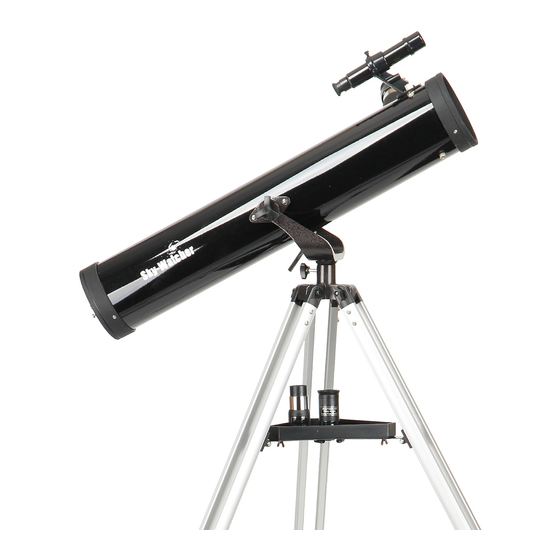Table of Contents
Advertisement
Advertisement
Table of Contents

Summary of Contents for SKY-WATCHER Refractor AZ2
- Page 1 INSTRUCTION MANUAL REFRACTORS/REFLECTORS WITH ALT-AZIMUTH MOUNT 090103V2...
- Page 2 AZ1 & AZ2 MOUNTS Refractor/AZ2 Dust Cap / Mask (Remove before Viewing) Dew Cap / Sun Shade Objective Lens Telescope Main Tube Finderscope Finderscope Bracket Re ector/AZ1 Alignment Screws Focus Locking Screw Eyepiece Diagonal Focus Tube Focus Knob Altitude ne-adjustment control Azimuth Lock Yoke Mount...
- Page 3 AZ3 MOUNTS Dust Cap / Mask (Remove before Viewing) Dew Cap / Sun Shade Objective Lens Piggyback Bracket Telescope Main Body Finderscope Finderscope Bracket Alignment Screws Focus Tube Eyepiece Diagonal Focus Knob Azimuth Flexible Control Cable Altitude Flexible Control Cable Azimuth Adjustment Knob/ Tube Rings Accessory Tray...
-
Page 4: Table Of Contents
TABLE OF CONTENTS Assembling Your Telescope For AZ1 & AZ2 Tripod Set up Telescope Assembly Finderscope Assembly Eyepiece Assembly For AZ3 Tripod Set up Telescope Assembly Finderscope/Red Dot FinderAssembly Eyepiece Assembly Operating Your Telescope Aligning the Finderscope Using the Red Dot Finder Operating the AZ1/AZ2 Mount Operating the AZ3 Mount Using the Barlow Lens... -
Page 5: Assembling Your Telescope
FOR AZ1 & AZ2 TRIPOD SET UP Fig.1 ADJUSTING TRIPOD LEGS (Fig.1) 1) Slowly loosen the height adjustment clamp and Fig.2 gently pull out the lower section of each tripod leg. Tighten the clamps to hold the legs in place. 2) Spread the tripod legs apart to stand the tripod upright. -
Page 6: Finderscope Assembly
FINDERSCOPE ASSEMBLY Fig.7 (re ector) (refractor) Fig.7 ATTACHING THE FINDERSCOPE (Fig. 7, 8) 1) Locate nderscope optical assembly. 2) Remove the two knurled thumbscrews near the end of the telescope main tube. Fig.8 Fig.8 3) Position the nderscope bracket over the screws in the telescope main body. -
Page 7: For Az3
FOR AZ3 TRIPOD SET UP Fig.1 ADJUSTING TRIPOD LEGS (Fig.1) 1) Slowly loosen the height adjustment clamp and gently pull out the lower section of each tripod leg. Tighten the clamps to hold the legs in place. 2) Spread the tripod legs apart to stand the tripod upright. Fig.2 3) Adjust the height of each tripod leg until the tripod head is properly leveled. -
Page 8: Finderscope/Red Dot Finderassembly
TELESCOPE ASSEMBLY Fig.5 INSTALLING CONTROL CABLES (Fig.5) 1) Slide the sleeve end of the cable over the nipple on the end of the worm gear. Secure the cable by tightening the set screw against the at surface on the nipple. FINDERSCOPE/RED DOT FINDER ASSEMBLY Small finderscope Large finderscope / Red dot finder... -
Page 9: Operating Your Telescope
OPERATING YOUR TELESCOPE Fig.b Fig.a These xed magni cation scopes mounted on the optical tube are very useful accessories. When they are correctly aligned with the telescope, objects can be quickly located and brought to the centre of the eld. Alignment is best done outdoors in day light when it's easier to locate objects. -
Page 10: Operating The Az1/Az2 Mount
Fig.g Altitude adjustment This telescope has an altitude(up-down)-azimuth(left-right) mount to control telescope movements. Loosen the azimuth lock knob to Altitude ne adjustment make left-right direction movements then tighten to lock. Loosen the altitude lock knob to make course up-down changes. Altitude Azimuth adjustment ne adjustments can be made by rotating the knurled wheel on the altitude ne adjustment rod after tightening the altitude lock... -
Page 11: Using The Camera Adapter Tube
When you connect a camera directly to your telescope for "prime focus" photography, you sometimes require an adapter so that the camera can be focussed. Some re ectors need more length than the focuser can travel, in order to focus the camera, and some refractors are designed to be used with diagonals, so when used with only a camera, their focal length has to be extended. -
Page 12: Calculating The Magni Cation (Power)
The magni cation produced by a telescope is determined by the focal length of the eyepiece that is used with it. To determine a magni cation for your telescope, divide its focal length by the focal length of the eyepieces you are going to use. -
Page 13: Observing The Sky
OBSERVING THE SKY Sky conditions are usually de ned by two atmospheric characteristics, seeing, or the steadiness of the air, and transparency, light scattering due to the amount of water vapour and particulate material in the air. When you observe the Moon and the planets, and they appear as though water is running over them, you probably have bad "seeing"... -
Page 14: Proper Care For Your Telescope
PROPER CARE FOR YOUR TELESCOPE Fig.n Collimation is the process of aligning the mirrors of your telescope so that they work in concert with each other to deliver properly focused light to your eyepiece. By observing out-of-focus star images, you can test whether your telescope's optics are aligned. -
Page 15: Cleaning Your Telescope
Aligning the Primary Mirror Find the three locking screws at the back of your telescope and loosen them by a few turns. Locking screw Adjusting screw Adjusting screw Locking screw If you see 3 large nuts protruding If you see 6 Phillip's-head screws from the back of your telescope but 3 protruding from the back and 3 small Phillip's-head screws... - Page 16 CAUTION! NEVER USE YOUR TELESCOPE TO LOOK DIRECTLY AT THE SUN. PERMANENT EYE DAMAGE WILL RESULT. USE A PROPER SOLAR FILTER FIRMLY MOUNTED ON THE FRONT OF THE TELESCOPE FOR VIEWING THE SUN. WHEN OBSERVING THE SUN, PLACE A DUST CAP OVER YOUR FINDERSCOPE OR REMOVE IT TO PROTECT YOU FROM ACCIDENTAL EXPOSURE.











Need help?
Do you have a question about the Refractor AZ2 and is the answer not in the manual?
Questions and answers